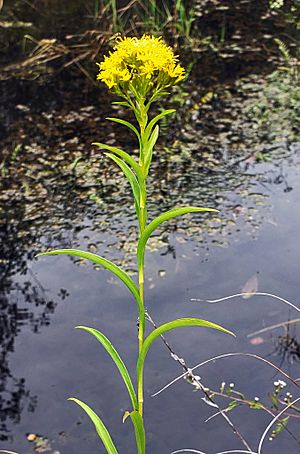Solidago riddellii facts for kids
Quick facts for kids Solidago riddellii |
|
|---|---|
 |
|
| Scientific classification | |
| Genus: |
Solidago
|
| Species: |
riddellii
|
| Synonyms | |
|
|
Solidago riddellii, also known as Riddell's goldenrod, is a beautiful plant found in North America. It belongs to the sunflower family and is a type of goldenrod. You can mostly find it growing near the Great Lakes and in the eastern Great Plains areas of Canada and the United States. It's sometimes grouped with other plants called Oligoneuron, but it's officially a Solidago and is part of a group known as "flat-topped goldenrods."
Contents
What Does Riddell's Goldenrod Look Like?
Riddell's goldenrod is a plant that comes back every year. It can grow up to 100 centimeters (about 40 inches) tall. This plant has a special underground stem called a caudex. This caudex helps it branch out. One plant can grow as many as ten stems above the ground!
Its Leaves and Flowers
The leaves of Riddell's goldenrod are long and thin. They can be up to 25 centimeters (about 10 inches) long. You can find these leaves growing along the stems and also at the base of the plant.
Each stem of Riddell's goldenrod can produce many small, bright yellow flower heads. Sometimes, one stem can have up to 450 of these tiny flowers! Each flower head is made up of two parts:
- Ray florets: These are like the "petals" you see around the outside. Each flower head has 7 to 9 of these.
- Disc florets: These are the small, tube-shaped flowers in the center. There are usually 6 to 10 of these in each flower head.
Where Does Riddell's Goldenrod Grow?
Riddell's goldenrod can be found in parts of Canada, including Alberta and Ontario. In the United States, it mainly grows in the prairie areas. These areas include Minnesota, Iowa, southern Wisconsin, northern Illinois, and Indiana. You can also find it in southern Michigan and Ohio. Sometimes, small groups of these plants are found far away in places like Georgia, Arkansas, and southwestern South Dakota.
Its Favorite Places
This plant loves to grow in wet places. You will often find it in wet prairies. It also likes marshy areas, which are like wetlands.

